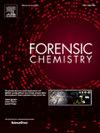Spectroscopy and chemometrics for differentiation of sex in human head hair fibers
IF 2.6
3区 医学
Q2 CHEMISTRY, ANALYTICAL
引用次数: 0
Abstract
Human hair is one of the most common pieces of evidence in forensics, however, it lacks a non-destructive, time-efficient, methodology for qualitative information. With the already well-established method for fiber analysis in spectroscopy and the common presence of Fourier Transform Infrared (FTIR) and microspectrophotometry (MSP) instrumentation in forensics, this study proposes chemometric approach to differentiate hair fibers on the sex assigned at birth. The IR and MSP hair sample spectra from different sexes were collected and, following spectral pre-treatment and mid-level data fusion, were used to calibrate a neural network model with 99.6% accuracy and 99.4% validation accuracy through an external validation dataset. This approach provides a robust model with significant qualitative information for forensic investigations that can be easily applied in forensic labs across the world. These results represent a rather small population size which would need to be expanded for real-world forensic applications.

人类头发纤维性别分化的光谱学和化学计量学
人类头发是法医学中最常见的证据之一,然而,它缺乏一种非破坏性的、时间效率高的定性信息方法。利用光谱学中已经建立的纤维分析方法以及法医学中普遍存在的傅里叶变换红外(FTIR)和显微分光光度法(MSP)仪器,本研究提出了化学计量学方法来区分出生时性别分配的头发纤维。收集不同性别毛发样本的IR和MSP光谱,经过光谱预处理和中级数据融合,通过外部验证数据集校准神经网络模型,准确率为99.6%,验证准确率为99.4%。这种方法为法医调查提供了一个强大的模型,具有重要的定性信息,可以很容易地应用于世界各地的法医实验室。这些结果代表了一个相当小的人口规模,需要扩大到现实世界的法医应用。
本文章由计算机程序翻译,如有差异,请以英文原文为准。
求助全文
约1分钟内获得全文
求助全文
来源期刊

Forensic Chemistry
CHEMISTRY, ANALYTICAL-
CiteScore
5.70
自引率
14.80%
发文量
65
审稿时长
46 days
期刊介绍:
Forensic Chemistry publishes high quality manuscripts focusing on the theory, research and application of any chemical science to forensic analysis. The scope of the journal includes fundamental advancements that result in a better understanding of the evidentiary significance derived from the physical and chemical analysis of materials. The scope of Forensic Chemistry will also include the application and or development of any molecular and atomic spectrochemical technique, electrochemical techniques, sensors, surface characterization techniques, mass spectrometry, nuclear magnetic resonance, chemometrics and statistics, and separation sciences (e.g. chromatography) that provide insight into the forensic analysis of materials. Evidential topics of interest to the journal include, but are not limited to, fingerprint analysis, drug analysis, ignitable liquid residue analysis, explosives detection and analysis, the characterization and comparison of trace evidence (glass, fibers, paints and polymers, tapes, soils and other materials), ink and paper analysis, gunshot residue analysis, synthetic pathways for drugs, toxicology and the analysis and chemistry associated with the components of fingermarks. The journal is particularly interested in receiving manuscripts that report advances in the forensic interpretation of chemical evidence. Technology Readiness Level: When submitting an article to Forensic Chemistry, all authors will be asked to self-assign a Technology Readiness Level (TRL) to their article. The purpose of the TRL system is to help readers understand the level of maturity of an idea or method, to help track the evolution of readiness of a given technique or method, and to help filter published articles by the expected ease of implementation in an operation setting within a crime lab.
 求助内容:
求助内容: 应助结果提醒方式:
应助结果提醒方式:


